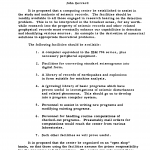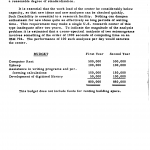Erster expliziter Entwurf einer Digitalen Bibliothek (1959)
18. März 2018 um 23:38 5 KommentareIch recherchiere (mal wieder) zu Digitalen Bibliotheken und habe mich gefragt, wann der Begriff zum ersten mal verwendet wurde. Laut Google Books taucht (nach Aussortieren falsch-positiver Treffer) „digital library“ erstmals 1959 in einem Bericht für das US-Außenministerium auf. Die bibliographischen Daten habe ich bei Wikidata eingetragen. Der Bericht „The Need for Fundamental Research in Seismology“ wurde damals erstellt um zu Untersuchen wie mit seismischen Wellen Atomwaffentests erkannt werden können.
In Anhang 19 legte John Gerrard, einer von vierzehn an der Studie beteiligten Wissenschaftler, auf zwei Seiten den Bedarf an einem Rechenzentrum mit einem IBM 704 Rechner dar. Da das US-Regierungsdokument gemeinfrei ist hier die entsprechenden Seiten:
Bei der geplanten digitalen Bibliothek handelt es sich um eine Sammlung von Forschungsdaten mitsamt wissenschaftlicher Software um aus den Forschungsdaten neue Erkenntnisse zu gewinnen:
The following facilities should be available:
- A computer equivalent to the IBM 704 series, plus necessary peripheral equipment.
- Facilities for converting standard seismograms into digital form.
- A library of records of earthquakes and explosions in form suitable for machine analysis.
- A (growing) library of basic programs which have proven useful in investigations of seismic disturbances and related phenomena.
- …
Klingt doch ziemlich aktuell, oder? Gefallen hat mir auch die Beschreibung des Rechenzentrums als „open shop“ und der Hinweis „nothing can dampen enthusiasm for new ideas quite as effectively as long periods of waiting time“. Die Bezeichnung „digital library“ bezieht sich in dem Text primär auf die Sammlung von digitalisierten Seimsmogrammen. Am Ende der Empfehlung wird abweichend der Begriff „digitized library“ verwendet. Dies spricht dafür dass beide Begriffe synonym verwendet wurden. Interessanterweise bezieht sich „library“ aber auch auf die Sammlung von Computerprogrammen.
Ob das empfohlene Rechenzentrum mit digitaler Bibliothek realisiert wurde konnte ich leider nicht herausfinden (vermutlich nicht). Zum Autor Dr. John Gerrard ist mir nicht viel mehr bekannt als dass er 1957 als Director of Data Systems and Earth Science Research bei Texas Instruments (TI) arbeitete. TI wurde 1930 als „Geophysical Service Incorporated“ zur seismischen Erkundung von Erdöllagerstätten gegründet und bekam 1965 den Regierungsauftrag zur Ãœberwachung von Kernwaffentests (Projekt Vela Uniform). An Gerrard erinnert sich in diesem Interview ein ehemaliger Kollege:
John Gerrard: into digital seismology, and he could see a little bit of the future of digital processing and he talked about how that could be effective in seismology, he was right that this would be important in seismology
In Birmingham gibt es einen Geologen gleichen Namens, der ist aber erst 1944 geboren. Ich vermute dass Gerrard bei TI an der Entwicklung des Texas Instruments Automatic Computer (TIAC) beteiligt war, der speziell zur digitalen Verarbeitung seismischer Daten entwickelt wurde.
Der Einsatz von Computern in klassischen Bibliotheken kam übrigens erst mit der nächsten Rechner-Generation: das MARC-Format wurde in den 1960ern mit dem IBM System/360 entwickelt (von Henriette Avram, die zuvor bei der NSA auch mit IBM 701 gearbeitet hatte). Davor gabe es den fiktiven Bibliotheks-Computer EMMARAC (angelehnt an ENIAC und UNIVAC) in „Eine Frau, die alles weiß“ mit Katharine Hepburn als Bibliothekarin und Spencer Tracy als Computervertreter.
Bis Ende der 1980er taucht der Begriff „digital library“ bei Google Books übrigens nur vereinzelt auf.
Data models age like parents
15. März 2018 um 21:51 Keine KommentareDenny VrandeÄić, employed as ontologist at Google, noticed that all six of of six linked data applications linked to 8 years ago (IWB, Tabulator, Disko, Marbles, rdfbrowser2, and Zitgist) have disappeared or changed their calling syntax. This reminded me at a proverb about software and data:
software ages like fish, data ages like wine.
â€
The original form of this saying seems to come from James Governor (@monkchips) who in 2007 derived it from from an earlier phrase:
Hardware is like fish, operating systems are like wine.
The analogy of fishy applications and delightful data has been repeated and explained and criticized several times. I fully agree with the part about software rot but I doubt that data actually ages like wine (I’d prefer Whisky anyway). A more accurate simile may be „data ages like things you put into your crowded cellar and then forget about“.
Thinking a lot about data I found that data is less interesting than the structures and rules that shape and restrict data: data models, ontologies, schemas, forms etc. How do they age compared with software and data? I soon realized:
data models age like parents.
First they guide you, give good advise, and support you as best as they can. But at some point data begin to rebel against their models. Sooner or later parents become uncool, disconnected from current trends, outdated or even embarrassing. Eventually you have to accept their quaint peculiarities and live your own life. That’s how standards proliferate. Both ontologies and parents ultimately become weaker and need support. And in the end you have to let them go, sadly looking back.
(The analogy could further be extended, for instance data models might be frustrated confronted by how actual data compares to their ideals, but that’s another story)


Neueste Kommentare